Sometimes, I feel bad about filtering the experience of being in a garden through a camera lens. Am I like one of those people who walk around seeing the whole world through the screen of their iPads? But the magic of photography can turn a frantic, 45-minute garden visit into hours of contemplation at home – letting me zoom in, identify hidden treasures, and take time to think. While the garden of Washington D.C. landscape designer Scott Brinitzer was structurally cool, what my photos make me think about now is the dark side of foliage.
Yes, the bone structure of Brinitzer’s garden is the first thing that impresses you. His plan frames the space with two long paths that meet at an axis marked by that blue pot you might have noticed in an earlier post. In the pot is a single spiky, purple plant, most likely a cultivar of Phormium tenax or New Zealand flax. [Ed: Okay, based on comments from those-in-the-know, read Cordyline whenever I say Phormium/NZ flax.]
In the long view, plant and pot are nicely silhouetted against the door of the shed, painted a shade of ochre I’d have to call “pumpkin pie.” Love the knocker. Note the colour: black. And what is ochre? It’s a colour ranging from yellow through orange and brown. Remember those colours: black and brown. You’ll see them again.
In fact, the botanical world has no true black. Some colours come close, like the stems or culms of the black bamboo arching at each corner of that axis. Most botanical blacks are a dark purple or red. That’s why there’s subtle affinity here with the Phormium. Only on inspection do you notice the colour of the bamboo. But as the darkest point in this textured composition of greens and golds, the NZ flax instantly grabs your focus.
Then you look to the right. And another locus of colour draws your attention. At first, you see the brown.
It’s the soft, wispy texture of brown sedge (Carex – there are various species and cultivars). It drags you down the pea-gravel path (more brown) to a dark slate patio (charcoal, but let’s call it black) for a better look. Now, you can see the groupings, with potted shrubs reaching towards each other on either side of a lion’s-head fountain – dark foliage on the left, greens and golds on the right. (Click any image to see the slideshow.)
In an ideal world, I’d be sitting in that black basket chair enjoying the view – with a refreshing beverage.
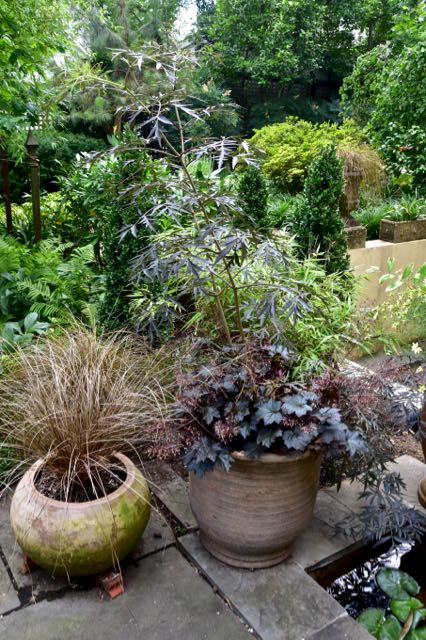
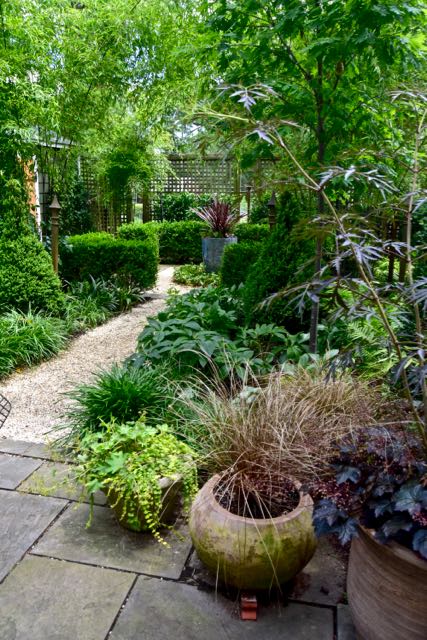
You have to be careful with black foliage – it works best in full sun, but in a too-shady spot can create visual holes. I like the counter-balancing sparks of white in this garden, such as those white chairs against the dark hedge a few pictures back, and the pearly surfaces of the black leaves in both plants below. Take a closer gander at this pairing of black on black. To me, it looks rich with an almost rococo texture. What do you think?
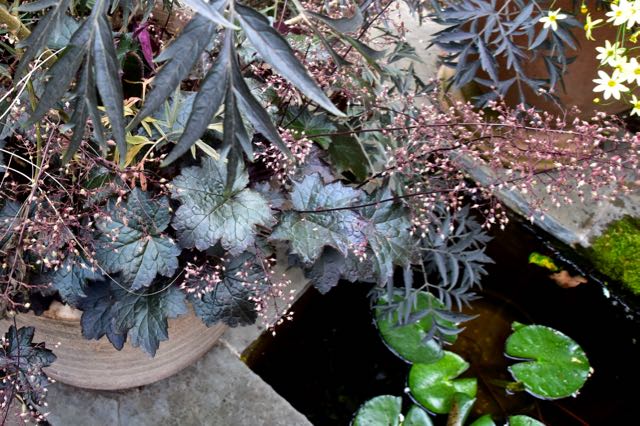
It took two circuits around this garden to take it all in on our visit during the Capital Region Fling, and much longer poring over and selecting images for this post to understand what I’d seen. Good gardens do that.
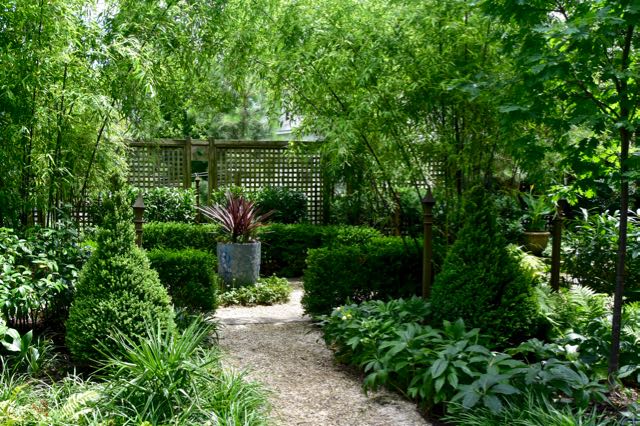
There’s so much to learn. That’s what I love about the great big world of botany, horticulture and garden design. For example, the picture below, chosen because it showed a brown foliage plant, sent me scurrying to identify it when I got home. Was it a fern? An evergreen? As I zoomed with my photo app, its leaf structure looked familiar. But could it be…? Do you know what it is? Give it a guess before you read the caption (don’t cheat by clicking this.)
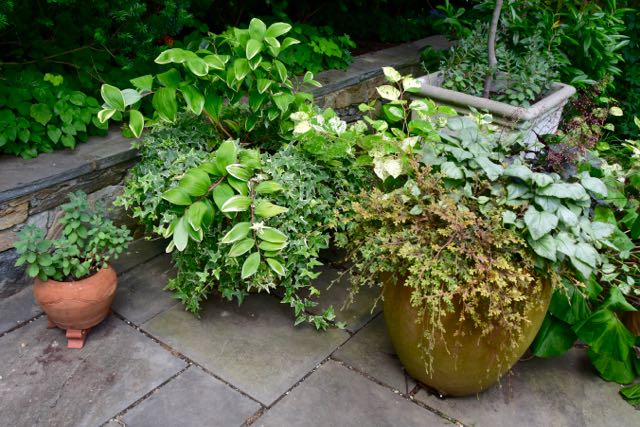
Did you guess the plant ID? And how have you used dark foliage in your garden?

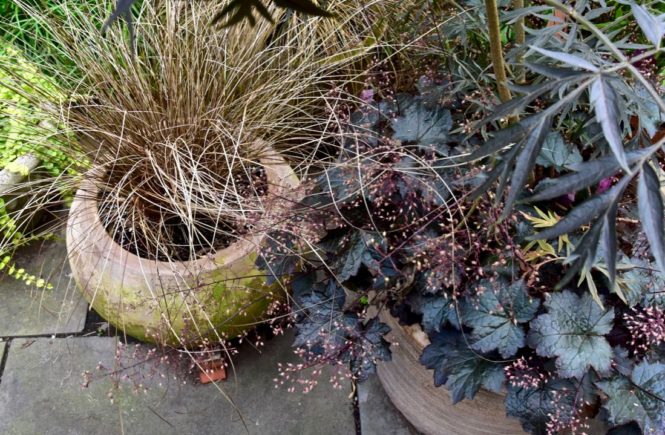
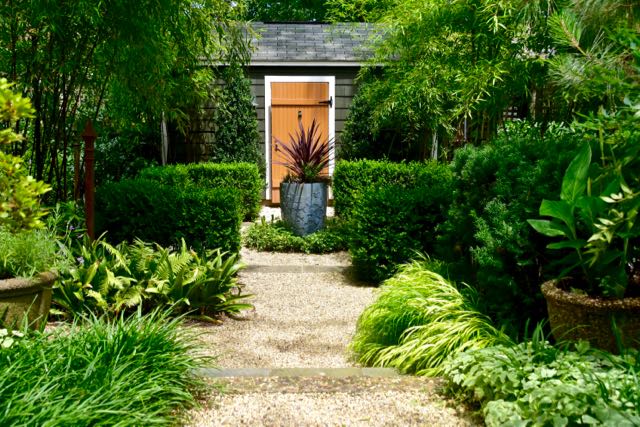
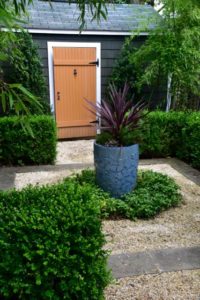
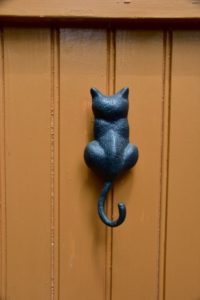
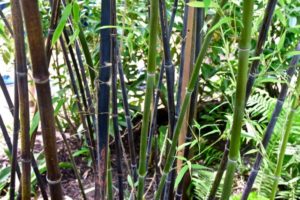
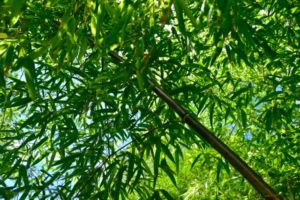
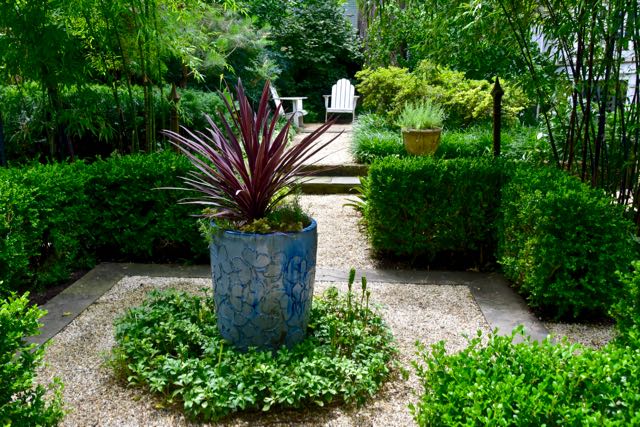
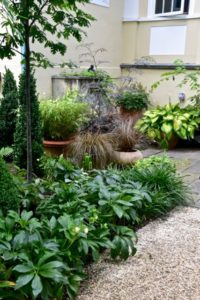
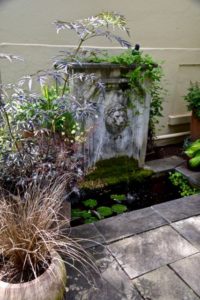
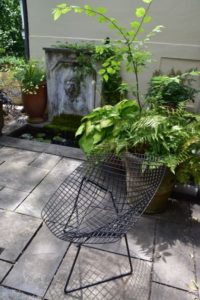
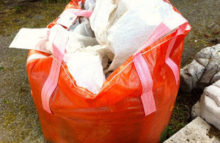

12 comments
Enjoyed your color and design musings, Helen. I thought that potted plant might be a cordyline, but perhaps it is a phormium. Yes, I feel exactly the same way about photographing so intently when I visit a garden on tour. I would like to be in the moment too, but having those photos later lets me figure out so much about the design and see the details I missed while walking through. Plus it lets me share the gardens with readers who weren’t there and so, I hope, share the pleasure of it with other people.
Pam, Spiky tropicals are not my forte, so you could be right about cordyline! If we had more time in a garden, we’d have more moments to have in-the-moments in! A short visit has me snapping away to document what I see. The picture you regret is the one you didn’t take.
What a fun look at this garden! I second Pam’s Cordyline ID, for whatever that’s worth. And yes, I knew that plant was a Selaginella, I saw so many of them on this Fling, all grown so well. I was so jealous! Must be the humidity? We can’t grow them like that here in the PNW.
That clinches it, my spiky friend. Cordyline it is. Did you see Selaginella in other gardens? I’ll have to take another look at my photos. But any tender plant like that is a rarity in the gardens I see every day.
Thanks for bringing a different perspective on this garden. I enjoyed it.
Thanks, Laura, and thanks for dropping by.
I love that garden, mostly all greens with just touches of other color. I’ll never have the discipline to do that. Thanks for the tour of a gorgeous garden.
I have a lot of black or near-black in my garden thanks to Aeonium ‘Swartzkopf’, Leucadendron ‘Ebony’, and the black-foliaged Lagerstroemias. I have the Aeonium scattered through an area of Proteaceae as a temporary filler while the Proteas grew, but they’ve become such an effective accent, they will stay.
Plenty of brown also, due to the drought we had for five years, but that wasn’t intentional!
I’m very envious of your Aeonium and Leucadendron – and all your warm zone beauties. I love Toronto, but would also love to be able to grow plants that thrive in warmer weather. Not envious of your drought, though. My sympathies.
On a big tour like this you have to take photos to remember where you were and what you saw. I think you did a fine job of grabbing the details and they obviously brought you to some thoughts. Nice to see your point of view.
Thank you, Lisa. I’m often surprised what I discover after the fact in photos – almost like the murder in the improbable 60s movie ‘Blow Up.’
Helen, your photos are outstanding! And I am partial to black (almost-black anyway) in the garden. Love that door knocker!
Thanks for your kind words, Jean. That knocker is charming, isn’t it?